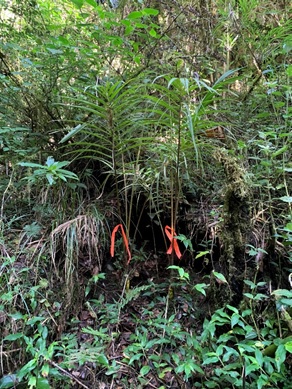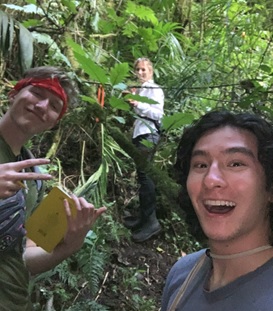
Two Palmito Morado planted at the same time 10 yrs ago.
Study by Leo Lerner, Josh Schauer, and Mary Thelen.
Palmito Morado (Perstoea acuminata) is a palm tree native to the highland forests of Costa Rica. Due to it being almost extirpated from the area, a restoration project in 2010 was started at Cuerici Biological Station. Although all the palms at Cuerici were planted in the same year, they range widely in size. The purpose of this study was to determine the factors that influence the size of Palmito Morado. We expected that palm trees growing in moist, nutrient rich soil with high canopy cover would be larger than palm trees growing in other environments. According to local experts who planted the trees, Palmito Morado prefers moist soil with high nutrient content in shady areas. Seventeen palms were sampled in the study. We recorded height, circumference of the base, and number of fronds as measures of palm size, however palm height was used as the main measure during data analysis. We measured soil moisture, soil nutrient content, canopy cover, and slope aspect of each palm. We ran a multiple regression test to determine if there were significant relationships between the height of the palm trees and their growing conditions. Nutrient content was removed from the model because we found it to be insignificant. We found significant positive relationships between soil moisture and palm height, as well as east-facing slopes and palm height. We found a significant negative relationship between south-facing slopes and palm height. Lastly, we found no significant relationship between canopy cover and palm height. According to our data, we would expect that palms growing in moist soil on east-facing slopes would be taller than palms growing in other conditions. Our data could provide important information on ideal habitat for Palmito Morado in future restoration projects.

Measuring palmitas (from L to R): Josh Schauer, Mary Thelen, and Leo Lerner.